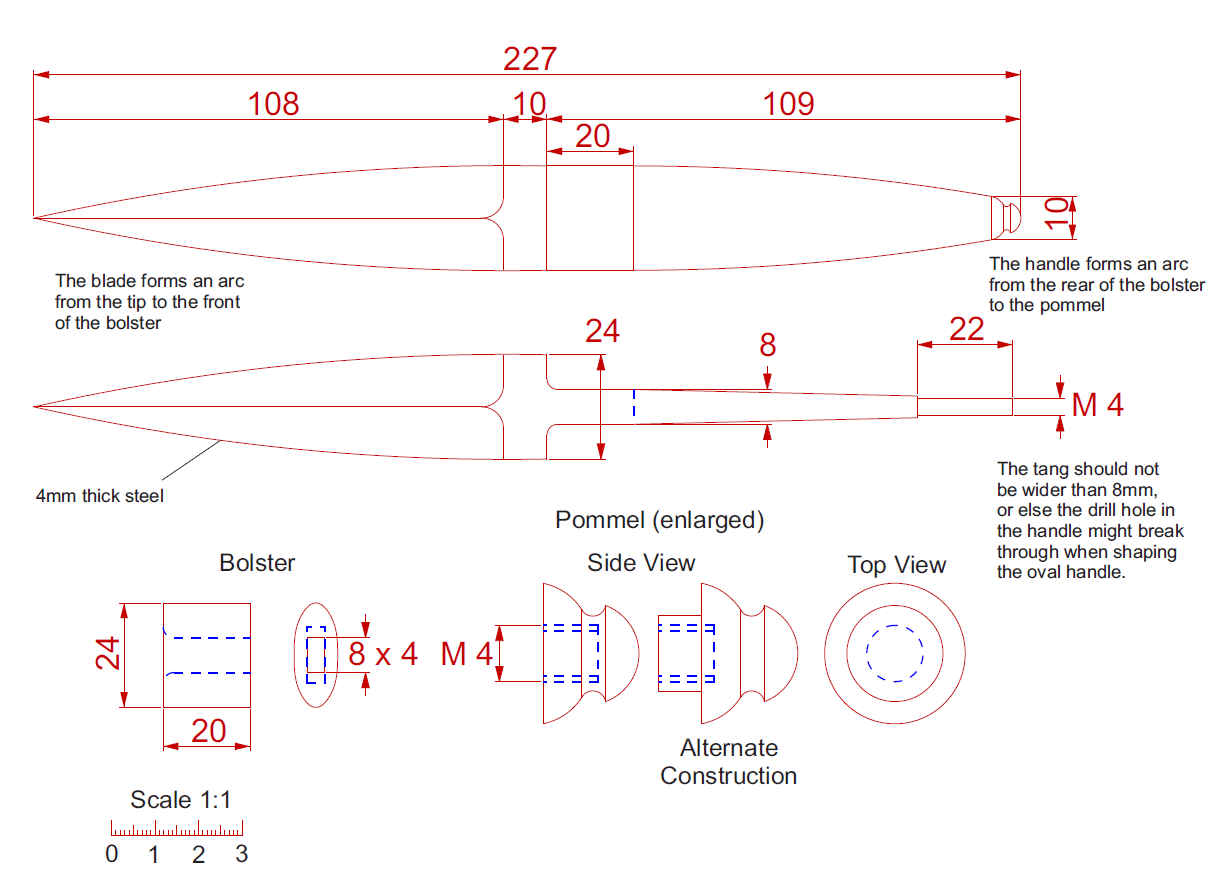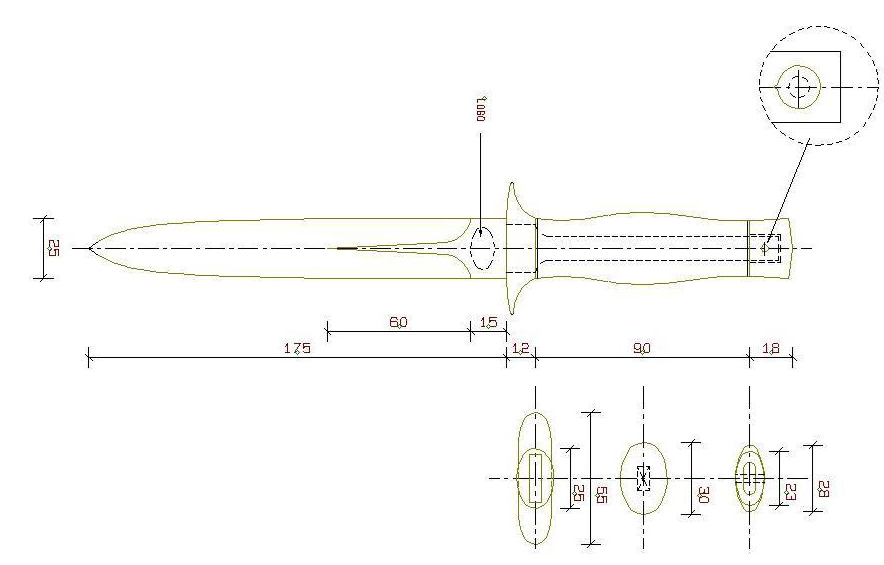- 1. Take time to make a thorough study of the evaluation schedule.
Select the process best suited to your methods of knife making. Make sure you
understand how your work will be evaluated.
- 2. The primary criteria for evaluation will be fit and finish.
- 3. The evaluation schedules have been designed to assess the
applicant’s ability to craft a knife of high quality.
- 4. Blade steel must be a recognised blade steel and
technical specifications as well as hardening and
tempering methods must be described.
- 5. Although the choice of bolster and handle materials are important
regarding the design and purpose of the knife, no points will be awarded for
fancy, rare or expensive material, other embellishments or engraving. Incorrect
choices of material or poor workmanship may however lead to lower scoring on
certain criteria. It is recommended that you do not
add any embellishments or engraving.
- Together with your knives the panel requires a well-presented
document depicting diagrams of your knives, showing and/or describing all the
design, internal workings and technical features. Where possible photo’s at
various stages of your knife, one photo directly after hardening and another
showing components before final assembly.
- 6. Your application must be accompanied by two letters of
certification and recommendation from Guild members. The Guild member must
certify that :- 1)The applicant made the knives, 2) he/she has seen the finished
knives, 3) he/she is of the opinion that the knives are of Guild quality and 4)
the applicant is of sound character.
- 7. Remember all fixed blade knives require sheaths, also made by
you.
- 8. Folding knife makers must submit
5 folders, of different designs.
- 9. Mechanisms must however contain a
positive locking mechanism in the open and close position, either Back lock,
liner lock, Slip joints may be submitted for evaluation..
Friction folders
and spring backs do not qualify according to the criteria above and for purposes
of this evaluation. No kit knives may be submitted.
- 10. Stock Removed Fixed blade makers
must submit 4 knives of different design, PLUS the prescribed boot Dagger, or
Combat Dagger. The prescribed design must adhere to the proscribed designs given
in all aspects, shape and dimensions.
- 11. You may submit a mixed bag of folders and fixed blades. Should
you decide to submit a mixed bag, one of your fixed blades
must be one of the prescribed daggers.
- BOOT KNIFE - Designed by Piet Grey

- BLADE Use any accepted blade steel,
4mm thick.
- BOLSTER The bolster is of one-piece
construction and is elliptical in section. No faceting or other ornamentation is
shown. This is left to the maker’s discretion.
- TANG The tang is 10mm wide where it
joins the blade so that two rivets can be used to attach the bolster. This
construction can gain maximum marks, but is optional.
- SPACERS Not shown but is optional.
- POMMEL The shape as per drawing must
be lathe turned and its diameter must be 10mm where it joins the handle.
- LOGO Must be applied where
indicated.
- HANDLE Material left to maker’s
choice. In selecting handle material consider the risk of shrinkage of certain
materials as this will have an impact on fit. The shaping of the handle in this
plane is left to the maker. The side view however, must conform to the drawing.
- SHEATH In designing the sheath, bear
in mind that a boot knife is carried concealed.
- Or
COMBAT DAGGER – Designed by Kevin Harvey

- The dagger is designed with strong
construction in mind, especially tang and point geometry.
- Guard and pommel from makers own
material selection, both 12mm bar stock.
- Handle of makers own choice. Oval in
cross section all over and smooth for comfort and grip.
- Cutting edge to be thin, less than
0,5mm.
- No embellishments. Emphasis on
symmetry and close fit and finish.
- Hollow grinding, any blade grind is
acceptable but a hollow grind with a small diameter wheel is preferred
- Tang to be solid knife steel right
through, 5mm thick, with brass plug to secure pommel by drilling and pinning
after final gluing and assembly, OR solid knife steel at least 2/3 of tang
length with soft steel extension (silver soldered or brazed, not welded).
- BLADE
- Use any accepted blade steel, 25 x
5mm thick at ricasso.
- Blade profile tapering gradually
down its entire length.
- Small tapering flat extending
ricasso down centre of the blade 75mm, symmetrical on both sides.
- GUARD
- The guard is of one piece
construction, stock size 55 x 16 x 12mm. Slot to fit tang 20mm at shoulder. Oval
55 x 14, at blade, curved slightly back on quillions (finger guards). Oval 25 x
16 at handle side.
- TANG
- Solid steel tang : Drill 6mm hole at
pommel end before hardening and plug with brass after hardening to accept 3mm
pin through pommel and plug. File small notch in 6 mm hole to prevent plug from
rotating whilst drilling 3mm hole.
- Soft steel extension tang: Grind
diagonal angle to increase solder area in tang, approximately 2/3 from blade.
Extend tang after hardening with mild steel 10 x 5mm, silver soldering or
brazing (not welding) to knife steel. Drill 3mm hole through pommel and tang
assembly after gluing.
- SPACERS
- Fit decorative spacers on both sides
of handle to complement handle.
- POMMEL
- One piece construction, stock size
28 x 18 x 12mm. Mill slot in pommel to accept tang 10 x 5mm. Shape pommel 23 x
12mm oval at handle and 28 x 12mm at end and 18mm long.
- LOGO
- Must be applied where
indicated.
- HANDLE
- Material left to maker’s choice.
Shape oval handle, 90mm long including spacers with oval 30 x 16mm in middle.
- SHEATH
- In designing the sheath, bear in
mind that it is a combat dagger which should be suitably firm, securing the
dagger in the sheath and probably worn on the side.
12. Bladesmiths must submit four knives (one their own damascus dagger), and
have passed their performance test. Refer to the marking schedule for detailed
instructions. Your five knives must be of different designs, to demonstrate your
ability to design and make more than one type of knife.
13. You may submit a mixed bag of folders and fixed blades. Should you decide to
submit a mixed bag, one of your fixed blades must be one of the prescribed
daggers.
14. Forged blade applicants may NOT submit a mixed bag.
15. All knives must be of your own design and “kit” knives where the blade or
components are pre-cut and purchased will not be allowed.
16. Due to the annual Guild Show, we do NOT accept applications after 31 May.
Please allow at least two weeks for evaluation.
17. The applicable nonrefundable evaluation fee that is equal to the annual
guild membership fee for the year, should accompany your application. This
amount includes evaluation and annual membership to March of the next year if
your submission passed. Bank detail : ABSA ; Account 4056808599; Branch code
632005
18. The knives should be very securely packed in a strong re-usable container,
as they have to be sent around the country to committee members. Points of
daggers / fighters should be especially well protected.
19. Your submission package should contain:
• your knives, with their sheaths
• a copy of the receipt of payment of your evaluation fee to the guild,
• your performance test knife and its certificate if you are submitting forged
knives,
• your two letters of recommendation from guild members,
• a copy of the receipt of payment to the guild,
• cleaning kit for forged knives,
• Description for each of your knives describing heat treatment, construction,
design considerations, materials etc. as well as relevant photos of various
stages in making your knives.
• and your application form.
20. Deliver your knives to :
John Arnold, 14 Phillip street, Poortview, Roodepoort. 1424
Or
Albie Wantenaar. 62 Holzgen Street Brackenhurst Alberton 1448
Or
Erich Vosloo 66 St Aubyn Road New Redruth Alberton 1449
Please remember to phone or e-mail John with
the necessary tracking numbers.
Tel:
Mobile: +27 82 389 2772 Email:
johnarnold5000@gmail.com
Members of the evaluation committee are : : Albie Wantenaar, Erich Vosloo and John Arnold
We would like to wish you every success with your application and don’t forget,
ask for advice from other Guild members and ask them to coach and guide you
through the process.